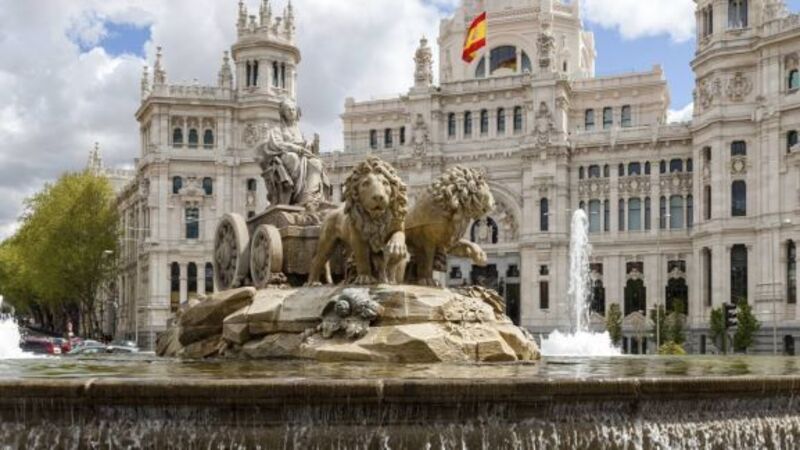Take pride in the magic of Madrid

Such popularity has downfalls: packed hotels, busy beaches and, most of all, an inability to walk down a street without meeting someone you know.
Sometimes, it’s nice to have anonymity, an opportunity to weave in and out of streets, and sample a different culture, without meeting your hairdresser, local shopkeeper or a workmate you don’t like.
That’s why Madrid is an under-appreciated alternative to your usual week in the sun.
You sacrifice beaches, of course, but with world-famous nightlife — just ask the estimated 200,000 who will converge on the city this week for the renowned Madrid Pride festival — every other delight of your typical, Spanish summer holiday can be enjoyed without the daily battle of securing a well-positioned sun-lounger.
Faced by similar financial burdens to ourselves, Madrilenos can be forgiven for feeling a little down on their luck at the moment. With close to half of the country’s population out of work, the final day of our recent visit is one of protest, with thousands marching through the streets over bank cuts.
The glum faces on every carriage of the wonderfully efficient metro system indicates that many feel like the weight of the financial world is resting on their shoulders, yet once it gets dark and the bars open, the city transforms.
It’s not all doom and gloom because in Madrid, even when under such severe financial pressure, they really know how to let their hair down.
One barman tells us there are more bars in the city than any other in Europe and, impressively but hardly surprising when you think about it, more than the whole of Norway. Sceptical? Walk along the narrow Calle de la Huertas, half a mile south of the city centre, and you will soon believe his boast.
A little dauntingly, when you first turn on to the thriving cobbled slope, you’ll be greeted by dozens of bar staff urging you to enter their place for a drink. There’s nothing untoward going on of course, just barmen and women desperate for some custom.
It can, admittedly, seem a tad in your face if your Spanish isn’t great but they’re also open to a bit of haggling if you’re up for a challenge. Their main aim, obviously, is to get you in for the night by enticing you with a first drink free.
But that’s not the way to do Madrid by night. In a city with so many choices, it would be wasteful to spend an entire evening in one location. With some of the more popular spots staying open until 7am, there is no rush and roaming is recommended.
You could, for instance, mooch around Huertas for a few hours, sampling various hostelries, before heading northwards to the flamboyant Chueca district which doesn’t really get busy until the early hours of the morning. That’s where this week’s Pride festival will be concentrated, brimful of colour and a fantastic carnival atmosphere.
In terms of a tipple, Madrid isn’t known for its fine beers, though the expansive choice of wine in various tapas bars is more than impressive, even if it’s the city’s eateries which leave a more lasting impression.
If you go to the right bars, you can live off free plates of tapas which accompany your canas (small glasses of beer which cost you anything from 70c to €2.50).
The most famous of these free tapas bars is El Tigre (Calle de las Infantas), where a gigantic plate of greasy, carb-filled goodness, is (sometimes literally!) thrown your way. It’s not pretty, with the décor comparable to an old students’ union bar, but value for money and atmosphere cannot be faulted.
A short walk away, however, is the real centrepiece of Madrid’s food scene. The Mercado de San Miguel, situated just off Calle Mayor, is a magnificent open plan space where dozens of restaurants, wine bars and cafés give you the widest choice of food imaginable.
Price wise it is a tad more expensive than other parts of the city but, when compared with medium-priced Irish restaurants, still represents great value.
While not containing the traditional Valencian ingredients of rabbit and snails, the paella served is delicious and at €7 for a plate or €4 for a tapas portion, still quite affordable.
Wash it down with a huge selection of wine from a nearby bodega, where a glass will set you back anything from €1.50 to €4.00.
Being so mesmerised by what was on offer, we ended up visiting the mercado on all five days of our trip, coming across something new to try each time.
It can get stiflingly busy, especially on Fridays and Saturdays when it stays open until 2am, though the eclectic mixture of locals and tourists makes for an electric atmosphere.
While Madrid doesn’t have a standout landmark compared with other major cities, the overall architecture along Gran Via, the main shopping street, and its surrounds makes it a picturesque, perhaps understated, place to explore.
For sports fans, there is a veritable feast. Obviously, it is near impossible to escape football, with Real shirts visible in every second shop front. Yet for much of last season, it was their less-successful city rivals Atletico who were thriving.
Based in the south of the city, on the banks of the Manzanares river, the Vicente Calderon Stadium is not as plush as Real’s world famous Santiago Bernabeú on the richer side of town, but it certainly has a unique charm to it.
With tickets available from €25 on the day of the game, it’s in stark contrast to the over-inflated prices the thousands who travel to England to see a game every weekend fork out, and well worth a visit if there’s a game which lines up with your trip.
Taking in some of the art, centred around the museum triangle near Atocha, is a must too.
The royal family’s collection at Museo del Prado is the most famous of the three galleries, featuring a selection of work from Francisco de Goya, though the Thyssen Museum (€9 entrance fee for an adult), which offers 800 different pieces from Picasso to late 20th century American artists, leaves a more lasting impression overall.
The third museum, Reina-Sofia, is dedicated to modern art. Yet it’s the architecture of the building which ends up being more impressive than any of the featured works. It’s also free on Saturday afternoons from 2.30pm onwards, if you’re looking to save some money for the inevitable festivities when the sun sets.
Both Aer Lingus and Ryanair have daily flights from Dublin, with the trip taking a little over two hours. The airport, Barajas, is situated at the north-eastern fringe of the city and is conveniently serviced by the Metro, with trains every five minutes. Flights from Dublin arrive into Terminal 1, however, so it is a 20 minute walk away from the Metro, which is located near Terminal 3.
We stayed at the inexpensive and perfectly located four star Hoteles Catalonia Gran Via on the city’s main shopping street. It’s a short walk to all of the main sights, with Gran Via Metro station 150m away if you’re planning a trip out of the centre of town. If you’re making a summer visit, the hotel has a seasonal rooftop pool, with a stunning view of the street below.
Although there is no iconic landmark, Madrid is a city with many smaller charms. From the stunning gothic architecture of the former postal headquarters (it’s now a local government office), to the museum triangle, there are several under-appreciated delights dotted around. And, thankfully with such searing summer heat, they are all within reasonable walking distance, too.
The main shopping district is centred on Gran Via, with the major international chains interspersed with local boutiques. There are also some top designers based in the capital, including Adolfo Dominguez, though you’ll need a heavy wallet to splurge at the flagship store near Lista Metro station!
While Mercado de San Miguel is the jewel in Madrid’s culinary crown, don’t be afraid to look a little further afield. Malaspina on Calle de Cadiz offers free tapas with a glass of its vast wine selection and also serves up some delicious full-sized meals at good prices. Make sure to sample the atmosphere at El Tigre too.





